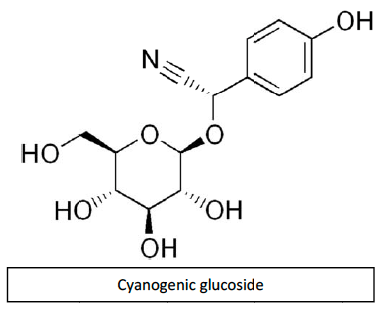
Sorghum & Sorghum-sudangrasses and frost
 Sorghums, and sorghum-sudangrass crosses may be poisonous if grazed or fed improperly. The danger of prussic acid poisoning is greatest for forage sorghum varieties, less for sorghum-sudangrass crosses, and least for surdangrasses.
Sorghums, and sorghum-sudangrass crosses may be poisonous if grazed or fed improperly. The danger of prussic acid poisoning is greatest for forage sorghum varieties, less for sorghum-sudangrass crosses, and least for surdangrasses.The young, dark green growth or regrowth (8 to 24 inches) the most dangerous stage. Shortly after frost, prussic acid release potential increases slightly. However, they can be safely grazed a few weeks after freezing if there is no substantial regrowth.
The amount of prussic acid is highest with high soil available nitrogen and/or low phosphorus.
Sorghums and sorghum-sudangrasses produce cyanogenetic glucosides during when growing. The intact, bonded cyanide and glucosides are not themselves poisonous. However, the glucosides break down into glucose sugars by addition of water when certain enzymes are present. This breakdown process frees the cyanide from its chemical bond, and it becomes the toxic prussic acid. The enzymes involved in the hydrolysis, or chemical decomposition, usually are present in the same plant--but may be available from other sources. Digestive juices may cause the hydrolysis to occur.

Normally cyanogenetic glucosides are physically separated from the enzymes that break the chemical bonds and release prussic acid. However, conditions that rupture plant cells to can allow the enzymes to convert the glucosides into prussic acid. Drought, freezing, cutting, chopping, chewing and maturity can contribute to plant cell rupture. The highest potential for poisoning occurs when animals consume plant regrowth following a frost or drought.
Since prussic acid poisoning is very fast-acting, death will occur quickly. Watch animals closely for any signs of toxicity. Symptoms of prussic acid poisoning are gasping, staggering, trembling muscles, convulsions, and death resulting from respiratory failure. The mucous membranes of the mouth and eyes may have a blue coloration as evidence of cyanosis. In cases of recovery, there appears to be no permanent effects.
In all situations potential for problem is worst in sorghums and less in sorghum-sudangrasses with little potential for problems from sudangrass. The potential for problem in sorghum-sudangrass may range from close to that or sorghum to little problem if the sorghum-sudangrass is more similar to sudangrass. Fall is a difficult time since repeated light frosts may continually rupture new cells and release prussic acid.
Recommendations:
In all cases, mixing with other feedstuffs reduces the problem compared to when the sorghum-sudangrass is the sole source of feed.
Silage. Sorghum and sorghum-sudangrass silage is generally sage for feeding. Although it may have contained toxic levels of prussic acid when harvested, while in storage much of the poison escapes as a gas during fermentation and when being fed. However, as a precaution, do not feed new silage for at least 3 weeks after harvesting and storing.
Hay. The prussic acid content of soghum-sudangrass hay decreases as much as 75 percent while curing and is rarely hazardous when fed to livestock. Hay stored for two or more months gradually losses all its cyanide potential.
Greenchop or grazing. Do not graze sorghum or sorghum-sudangrass hybrids following a series of light frosts, as the potential for poisoning increases for a period of time after frosts. Allow 7 to 10 days after a light frost before feeding greenshop or grazing. Do not green-chop graze sorghum or sorghum-sudangrass hybrids following a killing frost until the plant has dried, approzimately 7 days. Do not graze hungry livestock on sorghum or sorghum-sudangrass hybrids. Poisoning potential increases with the amount of high-risk forage consumed.
10.21.2013